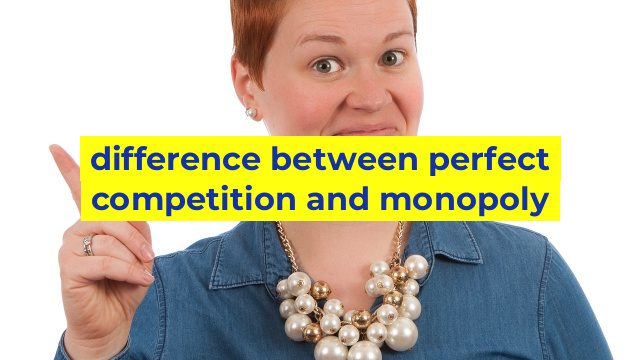Understanding the Key Differences Between Perfect Competition and Monopoly
Perfect competition and monopoly are two of the most important concepts in economics. While both are types of market structures, they differ from each other in terms of their characteristics and complexities. In this article, we’ll take a closer look at the key differences between perfect competition and monopoly.
Perfect Competition
Perfect competition is a market structure where there are numerous small firms operating in the market. In this structure, the following features can be observed:
- Homogeneous products: The firms in perfect competition offer identical products that cannot be differentiated from their competitors.
- Large number of buyers and sellers: Both buyers and sellers are in large numbers, and no participant is big enough to influence the price of the product.
- No entry or exit barriers: It is easy for new firms to enter the market, and existing firms can easily exit the market if they want to.
- Perfect information: All firms and consumers have access to all relevant information about the market and its participants.
- Price takers: All firms in perfect competition are price takers, which means they have no control over the price of their product. They must accept the prevailing market price.
In a perfectly competitive market, prices are determined by the forces of supply and demand. The equilibrium price and quantity are determined at the point where the quantity demanded equals the quantity supplied.
Monopoly
Monopoly is a market structure where there is only one firm in the market that provides a particular product or service. In this structure, the following features can be observed:
- Unique product: The firm in monopoly offers a unique product that has no close substitutes.
- No close competition: There are no other firms that offer the same product or service.
- High barriers to entry: The barriers to entry for new firms are very high, making it difficult for new firms to enter the market.
- Price maker: The firm in monopoly is a price maker, which means it can control the price of its product to a certain extent.
- Imperfect information: The firm in monopoly may have access to more information than its consumers, allowing it to control the market.
In a monopoly market, the firm has the power to set the price of its product. It will choose a price that maximizes its profit, which may result in a higher price and lower output compared to a perfectly competitive market.
Conclusion
In summary, perfect competition and monopoly are two very different market structures, with unique characteristics and complexities. Perfect competition is characterized by numerous small firms offering identical products, with no entry or exit barriers and perfect information. Monopoly, on the other hand, is characterized by a single firm with a unique product, high barriers to entry, and imperfect information. Understanding the differences between these two market structures is crucial in analyzing market behavior and deciding appropriate regulatory policies.
Table difference between perfect competition and monopoly
| Factor | Perfect Competition | Monopoly |
|---|---|---|
| Number of Sellers | Many | One |
| Control over Price | No control | Complete control |
| Barriers to Entry | Low | High |
| Product Differentiation | None | Can differentiate |
| Market Power | None | Significant |
| Economic Efficiency | High | Lower |


